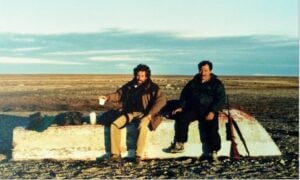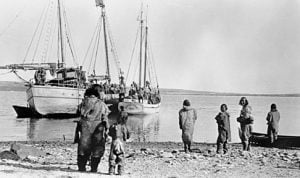This summer, I undertook an expedition to explore sites mentioned in the oral stories of my late great-grandmother Humahuk, who told me many tales related to the fate of the Franklin Expedition (1845-1848). A story she told more than once is of what she saw at a very young age while travelling with her family to the northwest side of King William Island in search of driftwood.
Close to the shore, they came to a small ridge scattered with very small pebble stones. There, Humahuk and her family discovered strange objects that they had never seen, objects that were round like the droppings of an Arctic hare — which turned out to be musket balls — as well as many other artifacts.
Humahuk’s father took one item that he later made into an ice chisel (in later years she learned it had been a dinner or butter knife). As they were looking for more objects they noticed a man-made mound the length of a full-grown person. At the end of it was a stone with strange markings on it. Seeing this, her father became afraid and they made their way down to the shore.
Once at the shore they found more strange objects: wood and a metal chain going into the sea.
Another Inuit story held that a family was camping at the eastern side of Washington Bay when a large number of Franklin’s men appeared, pulling a big wooden boat on a wooden skid.
I have travelled to the surrounding area three times by ATV in search of the objects that were on the shore. During the summer of 1992, Barry Ranford, a historian from southern Ontario, conducted a survey of the Erebus Bay shoreline in an attempt locate the objects that my great-grandmother described, but neither he nor I covered the many ridges that are in the area, nor have I since. According to Humahuk, there were two small islands nearby the place where they found the objects.
My great-grandmother was very young — about seven or eight — at the time her family made their trip around King William Island, but I’ve always thought her stories were worth investigating.
After months of preparations that included applying for an archeological permit from the Nunavut Government and securing funding for a camera, camping gear, ATV rental and gas, we were packed and ready to leave Gjoa Haven on July 25. We were delayed two days by heavy rain, but despite continuing rain we finally set off on July 27 on three ATVs fully loaded with everything we would need to live on the land for the next seven to 10 days.
Our load contained a four-man dome tent, three air mattresses, 69 litres of gas for the ATVs, one small gas stove with eight litres of fuel, a tool bag with spare bearings for the ATVs, enough food for six days, a fishing rod, a satellite phone, camera equipment, an emergency locater, a metal detector and extra clothing.
The team for the expedition consisted of myself; Jamie Takkiruq, a bright young high school graduate who participated in our 2015 Malerualik expedition and was keen to learn more about the history of the island; and Michael Eleehetook, a high school student who struggled with his work last school year but is very knowledgeable about on-the-land living, having been raised by his aging grandparents, and was also interested to know about the island.
Below is a diary of our trip.
July 27
We left Gjoa Haven despite the rain and high winds along the shore and travelled for six hours. Visibility was very poor due to the rain and fog. We stopped on the shore off Todd Island at a place called Booth Point and I told a story or two related to Todd Island and Starvation Cove to my companions. Then we pushed on to James Ross Point, where we camped for the night.
July 28
We got up early to pack and continued along the shore toward Douglas Bay. It was still raining but a bit lighter that the previous day. We crossed many small creeks, getting wet and muddy in the process. We stopped at Peffer River, where one of Franklin’s men was found with a pocket notebook, then continued to Douglas Bay. The rivers there were deep and muddy. We crossed where it was a bit rocky. One ATV got stuck but we were able to pull it out with the other two. After passing the rivers at Douglas Bay we took a shortcut to Peabody Point.








